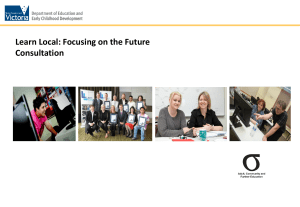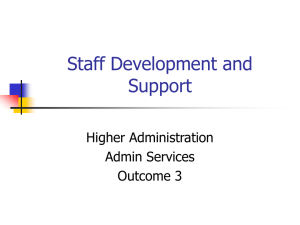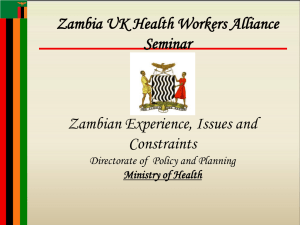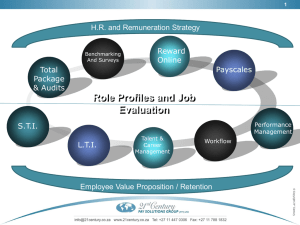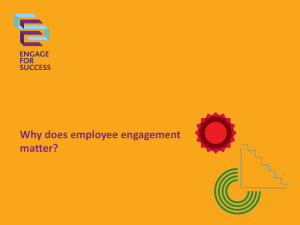Participation Branch Memorandum Learn Local: Focusing on the
advertisement
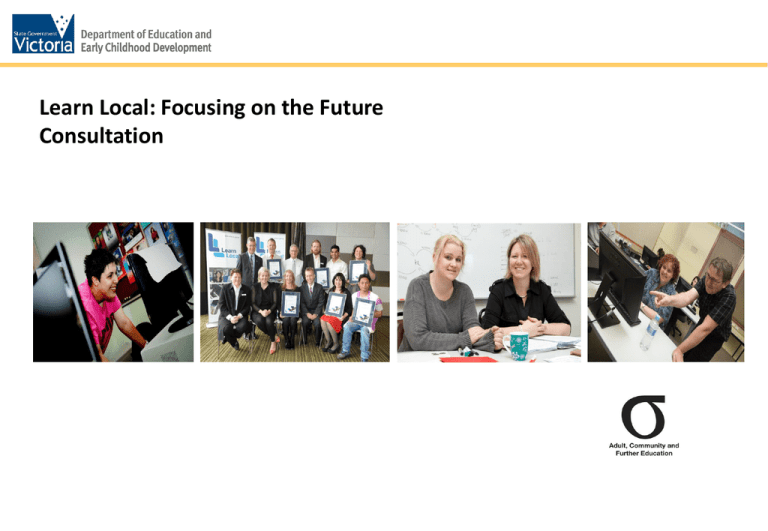
Learn Local: Focusing on the Future Consultation 1 Contents Context for consultation Co-location, new partnership models, communities of practice Mechanisms to support Learn Local organisations Next steps 2 Context for consultation Why are we here today? Commitment to consult: • identifying and supporting opportunities for colocation; • new partnership models; • support for Learn Local organisations involvement in communities of practice. Opportunity to help shape supports to assist Learn Local organisations 3 Implementation has begun - Capacity and Innovation Fund commitment $1 million committed in Learn Local: Focusing on the Future will support the Partnerships for Access stream. This will open later in 2014 following outcomes from this consultation process. Four Streams of Funding Available: • Pathways for achievement • Communities of Practice for Quality • Strengthening Key Provision • Partnerships for Access 4 Partnerships @ work in Learn Local Prahran Community Learning Centre (PCLC) and New Hope Foundation Grattan Gardens Community Centre PCLC and the New Hope Foundation share the premises at 40 Grattan Street. Many groups use the Centre and an estimated 750 people attend on a weekly basis. These include: • VCAL groups • Playgroups • Occasional Child Care • Computer classes • Yoga classes / 4 days • 35 ethnic groups who meet at GGCC each week • Immigration Settlement Services • Migrant English classes • Social work / counselling / youth and adult 5 Partnerships @ work in Learn Local Inner North Cluster (INC) Partnership was formed to develop common objectives in cooperation and to obtain efficiencies and economies of scale that strengthen program provision and increase outcomes for the communities of the inner north of Melbourne. • 6 Learn Local RTOs • Reference group of sector and nonsector stakeholders • Community service delivery focus • Shared expertise and increased efficiency 6 Partnerships – what you’ve already told us Opportunity to build on the collaboration and partnerships already evident within the sector to achieve further benefits. “There are opportunities to support more Learn Local organisations interested in undertaking additional functions such as training delivery and administration through networks.” “The Learn Local sector has developed informal and formal networks for a range of activities such as professional development, marketing and information-sharing.” Interest in opportunities presented by new models but recognised importance of local identify and autonomy. “Small providers of pre-accredited training were most cautious about changes to the operating model. However, they did support the ability of smaller networks to provide collegiate support and foster innovation.” “Some providers recognised that there needs to be a change in the model but they cautioned that it would require external investment, facilitation and time to build up a level of trust and allow for the cultural shift.” 7 Partnerships – why do it? • Reduce costs • Make better use of resources • Access to specialist skills • Improve the quality and reliability of services • Reduce organisation risk • To help another organisation • Demand pressures • Sustainability pressures • Increase breadth of delivery Are there other motivating factors your organisation experiences? 8 Context for consultation The benefits and challenges are well understood by the sector. Opportunity to consider the possibilities available to us all and the supports required to achieve them. Explore and discuss three elements: • identifying and supporting opportunities for co-location; • new partnership models; • support for Learn Local organisations involvement in communities of practice. 9 Contents Context for consultation Co-location, new partnership models, communities of practice Mechanisms to support Learn Local organisations Next steps 10 ‘Community Service Centres’ Co-location will depend on the particular learning needs of communities and the availability of existing services and infrastructure. Education precincts Employment services 11 Identifying and supporting opportunities for co-location What are the benefits of co-location? Profile and unified presence within a community Improved quality of facility than could be afforded by individual organisations Accessibility – location, but also other resources Support opportunities enhanced through the co-location of professionals Connections or partnerships Resource sharing i.e. utilities, cleaning and gardening Opportunity for rationalisation of older or less suitable facilities Capital costs compared to stand alone facilities 12 Workshop questions - Identifying and supporting opportunities for co-location What do you understand of the concept of co-location and the opportunities it presents? What are the challenges you are experiencing in pursing these opportunities? What support do you need from DEECD and the ACFE Board in pursuing these opportunities and addressing the challenges? 13 Contents Context for consultation Co-location, new partnership models, communities of practice Mechanisms to support Learn Local organisations Next steps 14 Partnership models Cooperation Alliance Merger Models for Collaboration Purchasing consortium Incorporation with existing entity Shared training delivery Shared corporate services Joint venture Shared facility Formal strategic alliance Federation 15 Partnership models What are the benefits of new partnership models? Improved access to training for students Sharing of specialist academic expertise in specific areas of training Quality of back of house services - less time working on administrative tasks Opportunity for greater market reach and greater opportunities for growth Opportunities to expand course offerings Reduced duplication resulting maximum use of facilities and services Reduced costs by the pooling of expertise and resources 16 Partnership models What do you understand of the concept of new partnership models and the opportunities they present? What are the challenges you are experiencing in pursing these opportunities? What support do you need from DEECD and the ACFE Board in pursuing these opportunities and addressing these challenges? 17 Contents Context for consultation Co-location, new partnership models, communities of practice Mechanisms to support Learn Local organisations Next steps 18 Support for Learn Local organisations involvement in communities of practice Long term benefits Common interests One organisation or many Communities of Practice Good practice Often informal Professional skills What are communities of practice? 19 Support for Learn Local organisations involvement in communities of practice Encourage sharing information and building collaborative practices Enabling employees to manage change, access to new knowledge and fostering a sense of common purpose amongst staff. Informal dissemination of valuable information, improvements in productivity and the fostering of innovation. Improved quality of programs, services and pathways for learners Reduction in costs of program development and compliance Improvement and innovation in training curricula, pedagogy and assessment that deliver high-quality training 20 Support for Learn Local organisations involvement in communities of practice What do you understand of the concept of communities of practice and the opportunities they present? What are the challenges you are experiencing in pursing these opportunities? What support do you need from DEECD and the ACFE Board in pursuing these opportunities and addressing the challenges? 21 Contents Context for consultation Co-location, new partnership models, communities of practice Mechanisms to support Learn Local organisations Wrap up 22 Mechanisms to support Learn Local organisations Cross-sectoral community of practice networks Clearer guidelines Longer activity schedules How can DEED and the ACFE Board best support Learn Local organisations in achieving strategic outcomes? Multiple-year funding contracts Capacity and Innovation Grant Program 23 Contents Context for consultation Co-location, new partnership models, communities of practice Mechanisms to support Learn Local organisations Next steps 24 Wrap up Involvement and ownership All partnerships require development and commitment over a sustained period Build awareness Define where we are going and why Deepen understanding Equip and activate leaders to drive change Create buy-in Use leverage and engagement at scale to build critical mass Take action Embed and sustain the change Make it stick Build and mobilise Engage for action Set direction Elapsed time 25 Next steps “The sector needs greater support in forming partnerships, alliances and networks, and integrating more effectively with other training providers and community organisations. This would provide a complete service for learners and result in programs being accessed by a greater number of people.” A further opportunity for Learn Locals to provide input through the survey circulated via Participation Branch memorandum also available at: http://www.education.vic.gov.au/training/providers/learnlocal/Pages/memo.aspx Tell us more by responding to: access.equity@edumail.vic.gov.au by Friday 4th April 2014. Contributions will help shape the Partnerships for Access stream of the CAIF and further implementation of commitments in Learn Local: Focusing on the Future. 26
